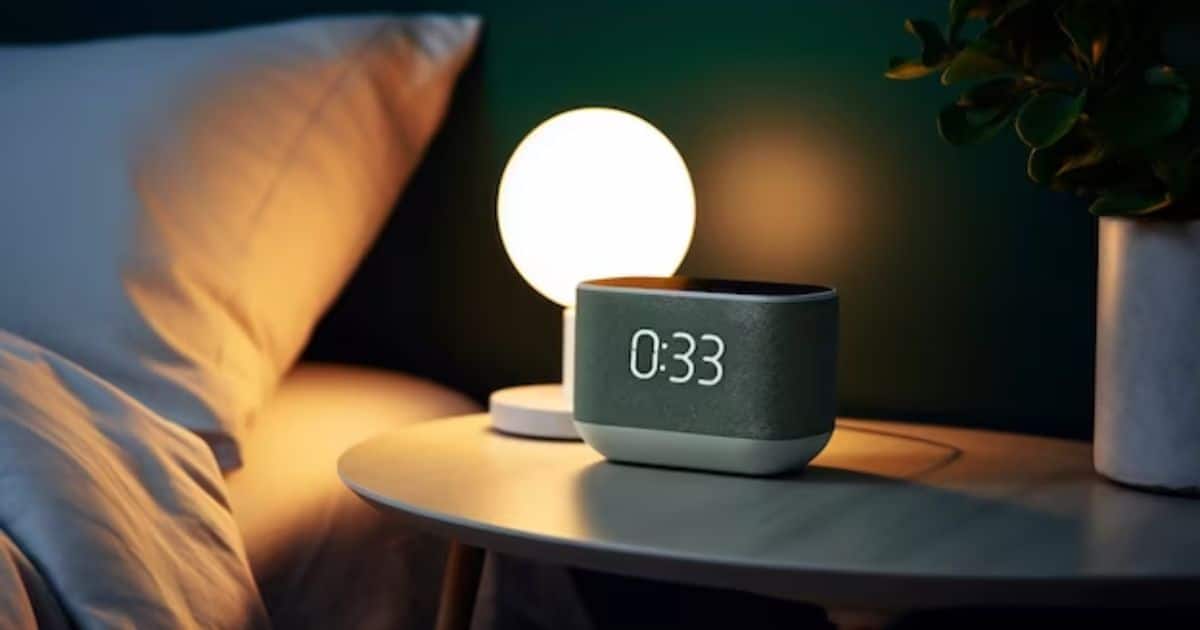A sleep training alarm clock aids in setting consistent sleep schedules for children by waking them at gradual intervals during the night. It has customized settings to gently rouse babies in 15-minute increments as they learn to self-soothe back to sleep. Consistent bedtimes and wake ups help establish healthy sleep patterns.
A mother’s struggle to get her toddler to sleep through the night inspired the creation of the sleep training alarm clock. Frustrated by constant night wakings, she tinkered until developing a product that softly plays nature sounds or classical music to calm fussy children asleep. Now parents globally rely on the clocks for peaceful nights.
This clock slowly increases volume over five minutes when it’s time for babies to wake. Touch-sensitive buttons allow caregivers to delay the alarm in 15-minute increments if needed. Melodies, nature sounds and light shows soothe without fully disturbing sleep. Babies adjust to longer stretches alone as critical learning develops. Households enjoy restored rest with the gentle but effective sleep training alarm clock.
How does a sleep trainer clock help

Introducing a sleep training alarm clock to your baby’s bedtime routine can be a gentle and effective way to encourage longer periods of uninterrupted sleep. This innovative clock is designed to gradually wake your little one with soothing sounds instead of a sudden, loud alarm, allowing them to ease into wakefulness. The clever feature of playing the noises quietly when your baby wakes up during the night, and gradually increasing the volume every few minutes, helps instill a sense of patience.
This method not only aids in teaching your baby that it’s not yet time to rise, but it also promotes the valuable skill of self-soothing, fostering their ability to fall back asleep independently. If you’re currently navigating the challenges of sleep training a breastfed baby, incorporating a sleep training alarm clock into your routine can be a valuable addition to promote a more restful night for both you and your little one.
The quiet noises of the sleep trainer clock are soothing. They help baby learn that night is for sleeping. Baby won’t be scared by a loud sound. The gradual increases in volume are gentle. They mimic how a parent would check on a baby to see if they need help settling back down. Soon, baby will sleep for longer stretches and wake up happy! The clock makes night wakings less stressful for parents and babies. Everyone can get a good night’s rest.
What age can I introduce a Sleep Trainer clock?

Here are some bullet points on what age a sleep training alarm clock can be introduced:
4-6 months: Many babies are starting to self-soothe and don’t need feeding at night by this age. A sleep trainer clock can help extend periods of sleep.
6-9 months: Between 6-9 months, most babies are developmentally ready to learn self-soothing skills. A sleep trainer clock provides a gentle way to teach independent sleep.
9-12 months: As babies get closer to 1 year old, inconsistent sleep schedules can lead to problems. A sleep trainer clock creates structure to help nighttime sleep improve.
12-18 months: Toddlers benefit from consistent bedtime routines and sleep associations. A sleep trainer clock reinforces these habits for better nights.
18 months-3 years: Preschoolers appreciate familiar sleep cues. A sleep trainer clock keeps bedtimes relaxed without parental presence in the room.
Consult your pediatrician: Every child develops differently. Your pediatrician can help determine when introducing a sleep trainer clock is appropriate for your baby’s needs.
Choosing which sleep trainer to buy

There are many sleep trainer clocks to pick from. Thinking about your baby’s needs will help you choose. Are they young, between 6-12 months old? Look for soft sounds and volume control. An older toddler may do well with nature sounds or lullabies too. Do you want to connect to an app? This allows schedule changes from your phone. Your budget matters too. Some basic clocks help most babies under $50, while connected options can cost over $100. Don’t get overwhelmed – any sleep trainer may make a difference.
Types of Sleep Trainers
Sleep trainers come in a variety of options to best fit individual family situations. Popular choices range from gradual sound models to playlist coaches to connected systems and basic sound machines.
Gradual Sound Trainers
These play soft noises and increase volume little by little. This mimics how parents check on babies to let them settle on their own. The steady increase in sound is gentle for young children.
Playlist Sleep Coaches
Instead of one repetitive tune, these offer playlists of nature sounds, lullabies or white noise. This keeps wake ups calming with a variety of options. Parents also like the screen-free experience.
CONNECTED SLEEP SYSTEMs
Connect online to set schedules and tracks sleep trends. Adjustments happen from the app when away. Great for traveling parents or those with busy days who want help monitoring baby’s rest.
Basic Sound Machines
Inexpensive choices perfect for modeling independent sleep habits. With just volume control and a few steady sounds, they aid young children in self-soothing at nighttime and naps too. Versatile for any family’s needs.
Tips While Introducing a Sleep Trainer Clock

It’s important to start the sleep trainer clock slowly. Begin by keeping it playing softly during naps. This lets baby get used to the sounds. Then, put it on low volume for night sleep. Gradually increase over a week until helping with night wake ups. Be consistent with bedtime routines too. A bath, book and cuddles tell baby it’s time for rest.
It may take some time for sleep training to work. Stick with the clock for at least 2 weeks before changing the plan. Some extra night wakings are normal at first while baby learns. Do not go to baby right away if they make noises in their crib. Try waiting 5-10 minutes before checking on them. This teaches self-soothing. Lots of praise and cuddles in the morning will motivate big kids to keep using their new sleep buddy!
Benefits for Parents and Children
Introducing a sleep training alarm clock provides advantages for caregivers and babies alike. For parents, it leads to rested nights, and children learn independent sleep skills through gradual guidance.
| Benefits for Parents | Benefits for Children |
| Get more uninterrupted sleep as baby learns to self-soothe | Develop healthy sleep habits and patterns with consistent wakes and bedtimes |
| Feel less stressed with fewer night wakings | Gradually learn to fall asleep independently without parental presence |
| Have more energy to focus on work/family during the day thanks to better rest | Are calmed by the gentle sounds rather than startled awake by a loud noise |
| Don’t need to keep getting up to check on baby as often | Feel securely soothed back to sleep without pickups or feedings |
| Enjoy peace of mind knowing baby is safely in crib with regulating sleep associate | Adjust to longer stretches of nighttime sleep which aids brain and body development |
| Appreciate a caring sleep solution that mimics comforting parenting techniques | Bond with parents through consistent bedtime routines each night and morning cuddles |
Considerations and Challenges

It’s normal for sleep training to be hard at first. Babies may cry when learning to self-soothe. Stay calm and consistent with the clock’s plan. In a few nights, crying often lessens as babies adjust. Be patient – it can take a few weeks to see results. Try making bedtimes earlier if short naps make nighttime harder.
There may be bumps in the road too, like sickness or teething pain disrupting sleep. The clock’s sounds could feel scary for overly tired kids. Take breaks as needed without too much TV or picking up. Incorporate back sleep pillow training to enhance your child’s comfort during naps and bedtime. Resume the routine when your child seems rested again. Ask for parent help if struggling. Getting grandparents involved on weekends can provide breaks to recharge strength for training. Stick with it, and your baby will thank you with peaceful sleep.
FAQ’s
Do sleep training clocks work?
Can OK-to-wake clocks help? Absolutely! These toddler alarms provide a simple visual cue for bedtime and wake-up rules. They create comforting routines for toddlers and preschoolers, making bedtime more predictable.
At what age should a child wake up with an alarm clock?
Most child development experts recommend starting an alarm clock routine between ages 5-7 years old, when children are school-aged and their bodies are developmentally ready.
How do I sleep train my toddler with a clock?
Start by introducing the clock during naptime so your toddler gets used to its sounds. Then use it at night on low volume, gradually increasing over a week.
Conclusion
A sleep training alarm clock can help babies get used to sleeping through the night. The quiet noises help the baby learn that it is time for sleep. The sounds are not scary like a loud alarm. The clock increases volume slowly. This mimics how parents check on babies to let them fall asleep by themselves.
Soon the baby will sleep for longer without waking up at night. Both baby and parents can rest well. The clock makes night waking easier. Baby is soothed by the calm sounds instead of crying. As the baby gets older, the clock still provides comforting sleep cues each night. Overall, a sleep training clock assists babies and toddlers in developing healthy sleep skills.










